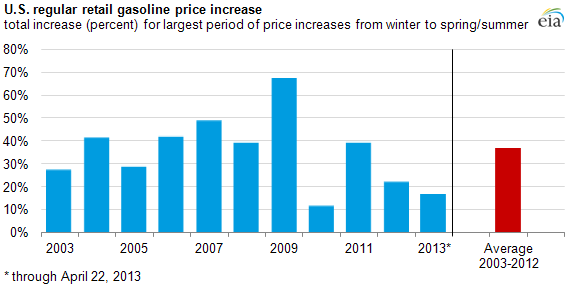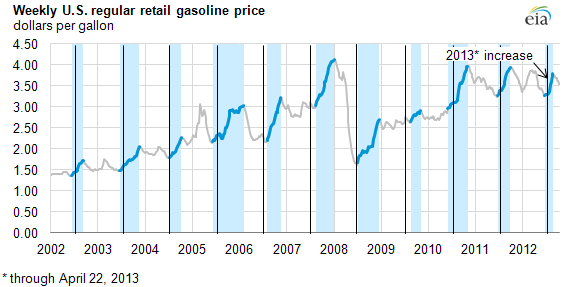
This year's gasoline price increase not unusual

Note: Because the period of increase is variable in timing and duration, percent increase is calculated over the period of price increase.
The average U.S. retail price of regular gasoline rose from $3.25 per gallon on December 17, 2012, to $3.78 per gallon on February 25, 2013. The increase is not unusual, as gasoline prices typically rise for an extended period around the first half of every year, although in some years, including this year, the price increase actually started in December.
The 16% rise from December 17 through February 25 was smaller than price increases in 9 out of the previous 10 years (see chart above). In absolute terms, this year's rise was the fourth smallest increase since 2003. The price fell by 24 cents per gallon to $3.54 between February 25 and April 15. If the average price does not rise above $3.78 per gallon again this season, the 2013 seasonal price increase will have the earliest ending date since the U.S. Energy Information Administration (EIA) began reporting weekly retail gasoline prices in 1991.
Although gasoline prices routinely increase from their winter lows through much of the first half of the year, the timing and duration of the increase varies (as shown by the blue shaded areas in the graph below). Over the past 20 years, the average period of rising prices in the spring has been 16 weeks, with the increase typically beginning in early February and ending around Memorial Day. In the past 10 years, the average duration of the price increase grew to nearly 19 weeks, with the increase typically beginning in early January and ending in mid-May.
In most years, the extended period of increasing prices ends by the end of May even though peak gasoline demand tends to be in June, July, and August. Notable exceptions occurred in 2006, when MTBE (Methyl Tertiary Butyl Ether) was phased out in most of the United States and refinery disruptions following Hurricanes Katrina and Rita in the prior fall significantly delayed normal maintenance schedules; and in 1994, which had a late second-quarter spike in crude prices.

Note: Magnitude of increase shown by dark blue line segments. Duration of increase shown by light blue columns. Mid-year shown by light grey vertical lines.
While periods of increasing prices always garner attention, especially when prices are at or near historic or seasonal highs (as they are this year, and were during 2011, and from 2003 to 2008), these data show the increase in early 2013 was somewhat predictable, with the prices over the past 10 years increasing by an average of 36% from their seasonal low to their seasonal high.
These seasonal increases are the result of several factors, including:
- Refinery maintenance: The peak refinery maintenance season occurs during the first quarter of the year after winter distillate (heating oil) demand declines and before gasoline demand hits its summer levels. During this time, gasoline production levels drop off, and inventories are drawn down. The reduced supply of gasoline can lead to higher prices.
- Switching to summer-grade gasoline: Late winter into spring is the time when refiners must switch from producing winter-grade gasoline to summer-grade blends, which requires refineries to halt operations so they can change processes. This downtime obviously reduces production of gasoline. By April, refiners are typically coming out of maintenance and turnaround and are ramping up production of gasoline. The industry isn't usually at peak production until May or June. Summer-grade blends are more expensive to make, and much of this cost is passed along to retail customers, resulting in higher prices at the pump.
- Increasing gasoline demand: Gasoline demand begins to rise during the spring months as warmer weather brings out more drivers. The tightening between the supply and demand ahead of the summer driving season can result in rising prices during the first half of the year.
- Rising crude prices: Because crude oil prices account for the largest share of retail gasoline prices, increasing crude prices lead to higher gasoline prices. Between December 7, 2012, and February 8, 2013, the price of Brent crude, the waterborne light sweet crude grade that drives the wholesale price of gasoline sold in most U.S. regions, increased nearly $12 per barrel, or nearly 28 cents per gallon.